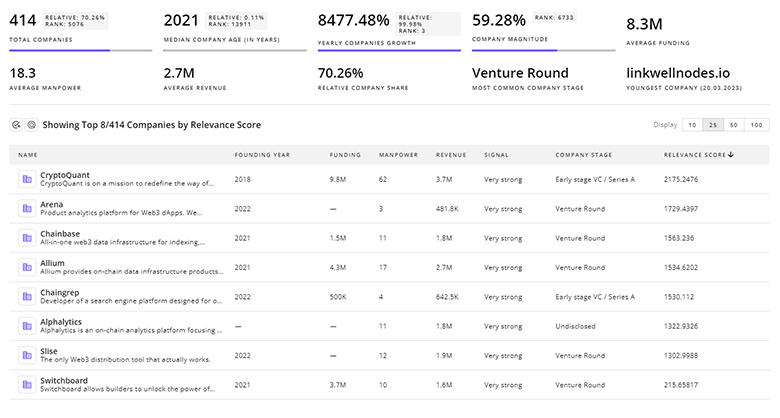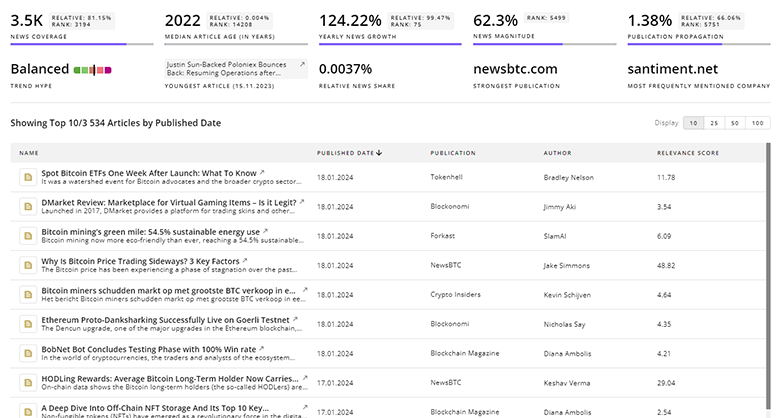
Data Center Networking Report
: Analysis on the Market, Trends, and TechnologiesThe data center networking market faces rapid specialization driven by AI and cloud growth, with the internal trend report estimating a compounded market acceleration at a 17.9% CAGR and sizeable capital flows into the segment. Market-size forecasts diverge by methodology but converge on strong growth: one market model values the sector at USD 30.78 billion (2025) while another positions fabrics and switch segments to expand materially through 2030–2034, reinforcing a near-term premium on high-bandwidth, low-latency interconnects and energy-efficient architectures Data Center Networks – Market Share Analysis Data Center Fabric Market Research Report.
We updated this report 19 days ago. Noticed something’s off? Let’s make it right together — reach out!
Topic Dominance Index of Data Center Networking
The Topic Dominance Index trendline combines the share of voice distributions of Data Center Networking from 3 data sources: published articles, founded companies, and global search
Key Activities and Applications
- Automation and AIOps for operational scale: closed-loop orchestration, telemetry correlation, and predictive remediation to reduce human-error outages and speed incident resolution.
- High-bandwidth transport for AI/HPC: deployment of 100G→400G→800G links (and emerging 1.6Tbps silicon/IP) to support training farms, model parallelism, and large dataset flows 8 Trends That Will Shape the Data Center Industry In 2025.
- Dense optical and co-packaged optics (CPO): move of optics closer to ASICs and use of multi-fiber engines to increase port density and lower link power per bit.
- Fiber densification and connector consolidation: high-fiber count connectors and ribbon/multi-gang assemblies to reduce touchpoints and enable future upgrade cycles Top Data Center Trends for 2025 – Molex.
- Energy and thermal co-design with networking: integrating power management, liquid cooling, and waste-heat valorization as network equipment account for a large share of site energy use.
Emergent Trends and Core Insights
- AI-led bandwidth and power shock: AI training clusters force simultaneous increases in network bandwidth and facility power; this drives demand for 400G+ fabrics, DPUs/IPUs, and design changes in power distribution and cooling 2025 Data Center Market Trends Report: Building for What's Next.
- So what: buyers will prioritize vendors that offer end-to-end co-engineering of interconnect, cooling, and power — pure switch refresh without power/cooling alignment increases TCO and deployment risk.
- Shift toward disaggregation and open networking: SONiC, white-box switches, and disaggregated NOS choices accelerate vendor competition and lower entry barriers for specialized silicon/software providers.
- So what: hyperscalers and large colocation providers will continue to drive demand for customizable, software-defined fabrics; smaller OEMs can win niches via tighter software integrations.
- Optical and fully-optical switching experimentation: patent activity and startups propose optical circuit/packet switching to lower latency and power at scale.
- So what: optical innovations promise step-changes in power and latency but require new ops skills and interoperability agreements to move beyond R&D.
- Edge and modular expansion: modular/prefabricated and metro/edge collocation deployments grow to meet low-latency and regulatory localization needs.
- So what: network designs will emphasize east-west fabric connectivity across distributed sites and compact high-density topologies for edge pods.
- Sustainability and energy reuse as competitive differentiator: waste-heat capture, renewable microgrids, and fuel-agile backup solutions emerge in procurement criteria DATA GUEDA.
- So what: procurement teams will include energy-return metrics (not only PUE) when choosing interconnect and facility partners.
Technologies and Methodologies
- High-speed Ethernet and next-gen IP stacks: 100G → 400G → 800G port deployments and emerging 1.6Tbps IP blocks to support extreme east-west traffic.
- Co-packaged optics and silicon photonics: CPO and SiPh reduce power per bit and path loss for rack-to-rack and rack-to-fabric links IC Photonics.
- Programmable DPUs, SmartNICs and IPUs: offload, telemetry enrichment, and in-network processing to accelerate AI and secure multi-tenant fabrics.
- SONiC/white-box and P4-programmable switching: disaggregated OS and P4 programmability allow custom forwarding behavior and rapid feature deployment Micas Networks.
- AI/ML for network operations and DCIM: predictive failure detection, capacity forecasting, and energy optimization converge in DCIM/observability platforms Coolgradient.
- Liquid and immersion cooling co-design: network and thermal architects pair to permit higher rack power densities and shorter cable runs for AI racks Accelsius.
Data Center Networking Funding
A total of 216 Data Center Networking companies have received funding.
Overall, Data Center Networking companies have raised $74.6B.
Companies within the Data Center Networking domain have secured capital from 787 funding rounds.
The chart shows the funding trendline of Data Center Networking companies over the last 5 years
Data Center Networking Companies
- Cornelis Networks — Cornelis delivers lossless, congestion-free scale-out fabrics built for AI and HPC that target predictable, high-throughput workloads. Their Omni-Path-heritage approach optimizes end-to-end latency and throughput for GPU clusters and HPC simulations; the company frames its value as network-led acceleration for compute efficiency and predictable application behavior, making it relevant for hyperscalers and AI labs.
- Nubis Communications — Nubis designs ultra-dense, low-power optical engines (XT1600™) that aggregate 1.6Tbps full-duplex per engine and map directly to modern SerDes, enabling compact, high-density rack-and-fabric designs that reduce power/bit for AI datacenters.
- Finchetto — Finchetto develops a fully optical, passive network switch that claims orders-of-magnitude power and latency improvements versus conventional silicon switches; the firm positions optical passive switching as a route to sharply lower switch energy and lower latency in AI cluster topologies.
- NetBox Labs — NetBox Labs commercializes the industry's leading open source network Source-of-Truth as a hosted SaaS (NetBox Cloud), enabling reproducible network models, automated provisioning, and integration with orchestration toolchains—critical for managing disaggregated fabrics and large white-box fleets.
- MangoBoost — MangoBoost combines DPUs and system software to improve AI datacenter efficiency, focusing on standards-based DPU acceleration, compatibility with commodity GPUs, and traffic optimization to lower cost and energy per training run.
Gain a better understanding of 3.3K companies that drive Data Center Networking, how mature and well-funded these companies are.

3.3K Data Center Networking Companies
Discover Data Center Networking Companies, their Funding, Manpower, Revenues, Stages, and much more
Data Center Networking Investors
Gain insights into 906 Data Center Networking investors and investment deals. TrendFeedr’s investors tool presents an overview of investment trends and activities, helping create better investment strategies and partnerships.

906 Data Center Networking Investors
Discover Data Center Networking Investors, Funding Rounds, Invested Amounts, and Funding Growth
Data Center Networking News
Gain a competitive advantage with access to 1.1K Data Center Networking articles with TrendFeedr's News feature. The tool offers an extensive database of articles covering recent trends and past events in Data Center Networking. This enables innovators and market leaders to make well-informed fact-based decisions.

1.1K Data Center Networking News Articles
Discover Latest Data Center Networking Articles, News Magnitude, Publication Propagation, Yearly Growth, and Strongest Publications
Executive Summary
Investors and operators must treat data center networking as a systems engineering problem where interconnect, cooling, power, and software co-design determine performance and cost outcomes. Near term, capital will flow to vendors that (1) deliver 400G+ and coherent optical capacity with low energy per bit, (2) provide programmable offload (DPUs/SmartNICs) and integrated observability for closed-loop operations, and (3) enable facility-level energy strategies (liquid cooling, waste heat reuse, renewable integration). For enterprises and colocation providers, the commercial imperative is to adopt modular, upgradeable fabrics and tighter supplier partnerships that align network refresh cycles with power and cooling upgrades. Buyers who align procurement to these technical and operational metrics will shorten time-to-value for AI/HPC workloads and materially lower lifecycle TCO.
We seek partnerships with industry experts to deliver actionable insights into trends and tech. Interested? Let us know!










